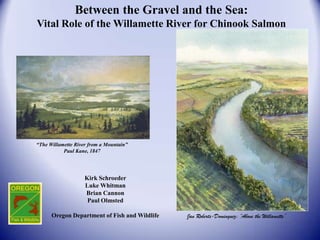
Between the Gravel and the Sea: Vital Role of the Willamette River for Chinook Salmon
- 1. Between the Gravel and the Sea: Vital Role of the Willamette River for Chinook Salmon “The Willamette River from a Mountain” Paul Kane, 1847 Kirk Schroeder Luke Whitman Brian Cannon Paul Olmsted Oregon Department of Fish and Wildlife Jan Roberts-Dominguez: “Above the Willamette”
- 2. Willamette Basin: Largest watershed in Columbia River Oregon 70% of Oregon Portland population Willamette Falls Largest urban areas in Oregon Dams block access to upper reaches of Salem Spring Chinook North Santiam River rivers Albany Corvallis South Santiam River Spring Chinook „threatened” species 1999 Harrisburg Recovery Plan 2011 Eugene-Springfield
- 3. General Life History – Spring Chinook Salmon Spawn: late August – late October Peak migration over Willamette Falls: Incubation and fry emergence: April – May December – April Rear 2 – 4 years in North Pacific Rear 5 – 15 months Most Willamette Chinook: 4 – 5 years old Migrate to ocean as smolts when they return
- 4. Progress: Starting Point “Spring chinook salmon are native to the Willamette River, with the mainstem river primarily a migration corridor for adults and smolts.” Bonneville Power Administration FY 2003 Provincial Project Review Willamette River = Migration Corridor River Management = “Flushing Flows” to push fish out of river Juvenile Chinook: simple life history hatchery fish emphasis
- 5. Origins of View 1. Legacy of Willamette as polluted river 2. Willamette as controlled river Dams control flow Hatcheries control fish production
- 6. Catch of Wild Juvenile Chinook in McKenzie at Leaburg Dam Migration from Spawning Areas
- 7. Migration of Juvenile Chinook past Willamette Falls Tagged at Leaburg Dam in fall or spring Spring migrants spend < 1 month – 3 months in Willamette Most Fall migrants overwinter in Willamette
- 8. Fry Dispersal & Rearing Santiam basin – early migration Influence of dams McKenzie – later migration Colder water Migration to lower Willamette & Columbia Fry dispersed throughout Willamette by late February to early March Most migrate as smolts in June & July March 2011 (1.5 – 3 inches)
- 9. Long Distance Fry Dispersal – What‟s up with that? Hypothesis: Adaptation to access productive rearing habitat in Willamette Visualization of upper Willamette River downstream of McKenzie confluence - 1850 Hulse et al. 2004. Ecological Applications 14: 325–341
- 10. Willamette Juvenile Chinook Diversity (Spread the Risk) Spawning Tributary Precocial Male Fall Spring Fry Fingerling 2-year Migrant Migrant Lower Tributary & Willamette River Winter-Spring Spring-Summer Summer Fall-Winter Spring Non-natal Streams Fall Feb- Fry Subyearling Migrant May Spring Migrant Mar- May- Jun- (Aug-Sep) Oct- Nov- Feb- Jun Jan- ? Jun Jul Dec Jan Apr Columbia River May- Mar- Apr- Apr- Jul May May Jun Ocean
- 11. Life History Diversity – Spreading the Risks Spawning Fry Migration Subyearling Dave Herasimtschuk © FI Yearling Aug Sep Oct Nov Dec Jan Feb Mar Apr May Jun Jul Aug Sep Oct Nov Dec Jan Feb Mar Apr May Jun Poor freshwater conditions Subyearling Yearling Year 1 Year 2 Year 3 Year 4 Year 5 Year 6 Poor ocean conditions Brian Franklin
- 12. Life History Diversity Provides Stability to Populations Proportion of returning adult Chinook that migrated as subyearling or yearling smolts 1998 – 2006 brood years McKenzie North Santiam South Santiam Clackamas 1998 2000 2003 2005
- 13. Dynamic Rivers provide Diverse Habitats that support Diverse Life Histories Pools for larger fish Refuge areas during floods Productive riffles Narrow channels with shade New gravel bars & Small side channels islands Cold water pockets Shallow edges for fry Willamette River downstream of McKenzie confluence
- 14. Challenges Progress = continual growth “What happens if you get to the cliff and you take one step forward? Or do you do a 180 turn and take one step forward? Which way is progress? The solution to many of the world‟s problems is to turn around and take a step forward.” Doug Tompkins from the documentary 180 South Full Steam Ahead?
- 15. Measuring Progress Life History Diversity Channel complexity Working Farms & Conservation Native Species Richness Connect People to River Water Quality Historic Trajectory Progress? Historical Willamette River Channel Change - S. Gregory, L. Ashkenas, D. Oetter, P. Minear, K. Wildman
- 16. In honor of Jim Sedell (1944 – 2012) Within the time scale of a person’s lifetime and the lifetimes of his or her children and grandchildren, entire ecosystems change. Ironically, however, it is within this time scale that people are most blind to changes occurring around them.
